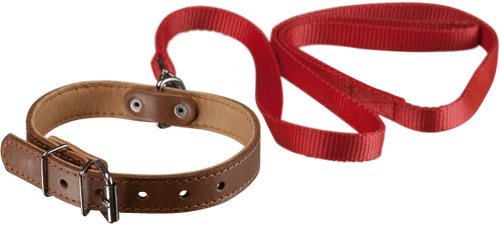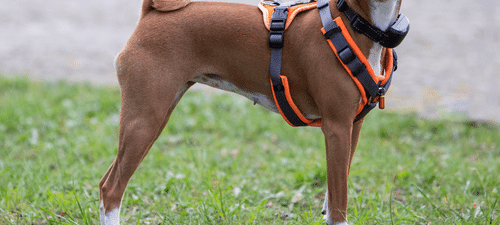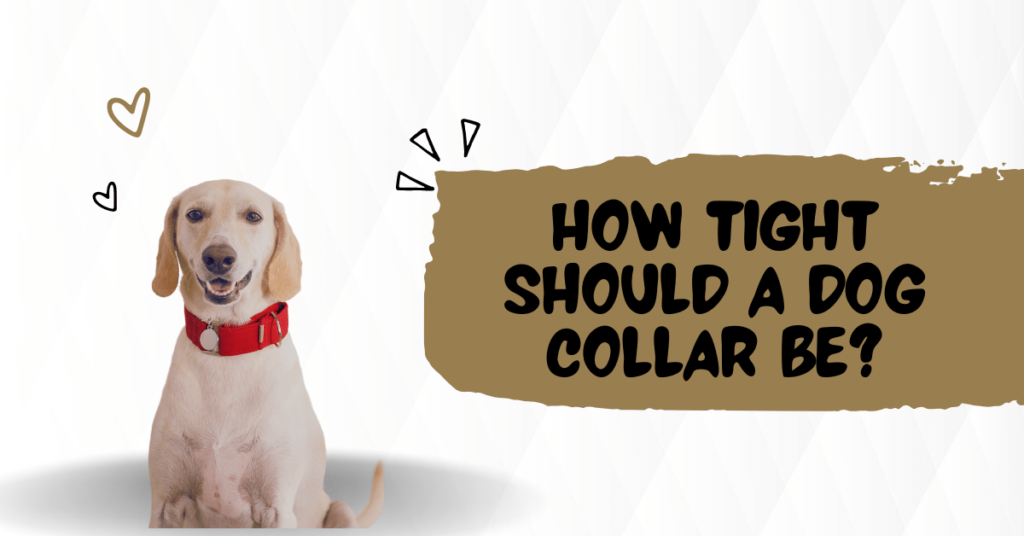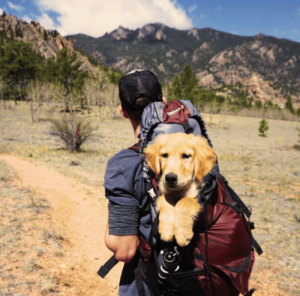Have you ever wondered, How tight should a dog collar be? Let’s talk about the ‘two-finger’ rule. Once you’ve fastened your dog’s collar, you should be able to slide two fingers under the collar easily. Choosing the right collar for your furry friend is like finding the perfect fit for your favorite shoes – it must be just right.
However, getting the right fit for your dog’s collar isn’t just about using the ‘two-finger’ rule. There are other things to think about, like:
- How big is your dog?
- What type of collar do you pick?
- What breed are they?
All these things matter regarding ensuring the right collar for your dog. So, let’s dive in and learn how to find the perfect fit for your furry friend’s collar together.
What is a Dog Collar And What Is Its Importance?

Before measuring a dog collar’s tightness, let’s first explore what a dog collar is and how tight it should be. Many of you already know what a dog collar is. It’s like a special necklace for your furry friend! Dog collars are those bands you put around your dog’s neck, usually with a buckle or clip. They’re not just for decoration. But they’re more than just accessories. It is used for training, and You can easily control your dog with a dog collar.
Many dog collars are on the market, but the most common are buckle collars, margarita collars, etc. We will discuss each collar in detail.
Types of Dog Collars and How They Affect Tightness:
There are different types of dog collars out there. Each collar has its pros and cons. Let’s look at them to find the best one for your dog.
- Buckle Collars: The most common type of dog collar. It is similar to a belt. It is so easy to put on and take off. Buckle collars come in different materials like nylon, leather, or fabric. It is perfect for everyday use.
- Martingale Collars: This collar consists of two loops. One fits around dog necks and has a smaller loop attached to it. The smaller loop tightens slightly when your dog pulls. So, it gives control without choking.
- Harnesses: It is for walking dogs. Technically, it’s not a collar. It distributes pressure across the dog’s body. It reduces stress on the neck and provides better control.
- Choke Chains: These are also called slip collars or training collars. These chains tighten when your dog pulls. Most of the dog’s owners use this for training purposes. It’s important to watch your dog when wearing these collars.
- Prong Collars: It is similar to a choke collar and is used for training. The main difference is it has metal prongs that press into the dog’s neck. At the same time, the choke collar tightens around the neck when the dog pulls.
- Head Collars: It fits over the dog’s muzzle and neck. It is similar to a horse halter. This collar is widely used for training purposes.
- Breakaway Collars: These collars are designed for dogs who spend time outside. These collars release or break apart if the dog becomes entangled.
How Tight Should a Dog Collar Be?
The two finger rule is gold standard for gauging collar snugness. Your dog’s collar should allow you to slide two fingers easily underneath. This ensures it’s not too tight to cause discomfort or breathing difficulties. Moreover it is secure enough to prevent slipping off.
There are some other things you should keep in your mind.
Safety First
Your dog’s collar should fit well too tight might hurt their neck or make breathing hard. A good fit also means their ID tags are easy to see. So, the right fit helping your furry friend out of harm’s way.
Customizing the Fit
As we know every dog is unique. So, different breed and size require different tightness.
- Dogs like Labrador Retrievers, German Shepherds, and Golden Retrievers require slightly looser collars.
- High energy dogs, like Border Collies, Australian Shepherds, and Boxers, may require looser collars for unrestricted movements.
- Thick necks dogs such as Bulldogs, Bull Terriers, and Mastiffs, may require looser collars. It prevents discomfort level.
- Chihuahuas, Yorkshire Terriers, and Toy Poodles Dogs require snugger collars. These breeds have delicate neck.
- Greyhounds, Whippets, and Salukis dogs requires snugger collars to prevent slippage.
- Houdini-like dogs have escape ability so, they also require snugger collars.
Comfort Is Key
When it comes to your dog’s comfort, knowing how tight a dog collar should be is essential. Comfort directly impacts on well being and happiness of your furry friend, A comfortable collar prevents discomfort and skin irritation. When you priortized the dog’s comfort it will foster a positive relationship. Right fitted collar allow natural movement of dog without restriction.
Troubleshooting
There are many challenges when it comes to right tightness of your dog’s collar. Here we’ve discussed some major and their solution.
Difficulty Finding the Right Fit:
It can be tricky to determine the perfect tightness.
Solution
Use the “Two-Finger Rule” to gauge the tightness.
Collar Slipping or Moving Out of Place
Solution
Use a martingale collar or harness to add security.
Skin Irritation or Chafing
Collars made from rough materials can cause skin irritation or chafing.
Solution
Regularly inspect your dog’s neck for any signs of irritation, Use collars made from nylon or leather.
Resistance to Wearing the Collar
Some dogs may resist wearing their collar.
Solution
Gradually introduce your dog to wearing the collar. Start with short periods of wear and gradually increase the duration.
How Do You Measure Your Dog’s Collars?

Measuring your dog’s collar is super important. It’s just like making sure your clothes fit right. A collar that doesn’t fit properly can cause your furry friend distress. Here’s how to do it easily.
Steps:
- Use a soft measuring tape to measure your dog’s necks.
- Wrap a tape snugly around your dog’s neck where the collar will sit.
- Make sure it’s snug but tight enough.
- You should be able to fit two fingers comfortably between the tape and your dog’s neck.
- Use a piece of string or ribbon if you don’t have a soft measuring tape. After measuring, lay the string flat against a ruler to determine its length.
- It is important to measure the dog’s neck circumference accurately. Moreover, neck sizes can vary, so measuring each dog’s neck is essential.
Note:
Don’t measure the existing collar because The same size from different companies may vary.
Alternatives To Dog Collars:

You may have heard some drawbacks to using collars, like Tightness, Safety, and comfort. So, you may be thinking of alternatives to dog collars. Well, here’s the good news: there is an alternative – it’s called a harness collar.
Harness Collars:
A harness collar is a great option if your dog has sensitive skin or pulls a lot. The harness collar fits around the dog’s body. It distributes the pressure more evenly. It is good for dogs with respiratory issues or neck injuries.
Types of Harness Collars:
Harness collars come in different types.
- Back-Clip Harnesses: Back-Clip is easy to put, controls more dog movement, and is comfortable for your dogs. It features a leash attachment on the dog’s back.
- Front-Clip Harnesses: Front-Clip features the leash attachment on the dog’s chest. It discourages pulling by redirecting the dog’s forward motion.
- No-Pull Harnesses: This collar provides effective control during walking. It adds pressure to the neck and throat area.
Pros And Cons of Harness Collars:
There are some pros and cons of using harness collars.
Pros:
- Harness collars distribute the pressure on the whole body. It reduces strain on the neck.
- During jumping, pulling, or lunging, it provides better control.
- There is no risk of slipping or escaping the dog in the harness collar. It is more secure than traditional dog collars.
- It comes in various sizes and styles, so it fits perfectly.
- Harness collars can be used for walking, hiking, and even car rides.
Cons:
- Improper fit may cause chafing or rubbing against the dog’s skin.
- A full-body harness may trap heat against the dog’s body in hot weather.
Final Thoughts on How Tight a Dog Collar Should Be
So, from the above discussion on “How Tight Should a Dog Collar Be” it’s important to use right collar for your dog. We’ve talked about everything like starting from what is dog collar to different types of collars available to use. There are many collars you can use alternatively like harness collars. But keep in mind each collar has it’s ups and down. Moreover alway think and upgrade yourself for comfort and happines of your furry friend.





